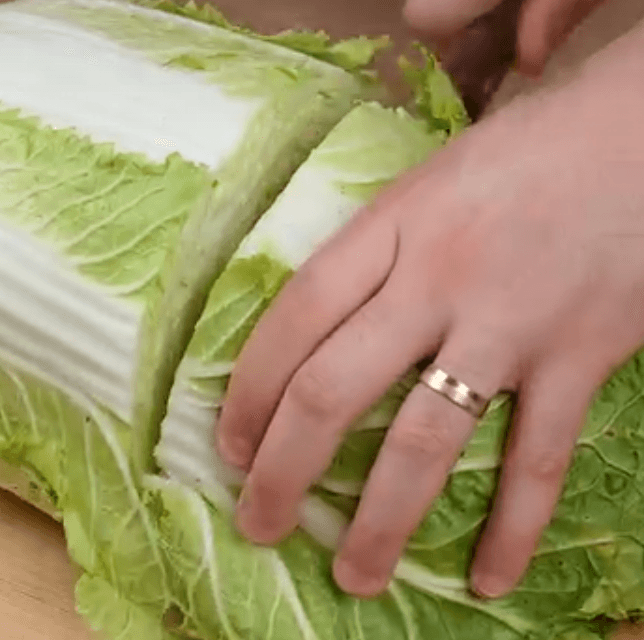Kimchi is a traditional Korean side dish made from fermented vegetables, primarily napa cabbage and radishes, with a variety of seasonings. This dish is known for its rich, spicy flavor and its health benefits due to the fermentation process. Making kimchi at home is not only satisfying but also allows you to customize the spice level to your preference. Here is a step-by-step guide to making authentic Korean kimchi.
Ingredients:
For the Kimchi:
- 1 large napa cabbage
- 1/4 cup sea salt (for salting the cabbage)
- 1 tablespoon rice flour
- 1 cup water
- 1/4 cup Korean red pepper flakes (gochugaru)
- 1/4 cup fish sauce
- 4 cloves garlic, minced
- 1-inch piece of ginger, minced
- 1 tablespoon sugar
- 4 green onions, chopped
- 1 medium carrot, julienned
- 1 radish, julienned
- 1/4 cup salted shrimp (optional)
Instructions:
Step 1: Preparing the Cabbage
- Cut the Cabbage: Start by cutting the napa cabbage into quarters lengthwise, and then into bite-sized pieces.
- Salt the Cabbage: Place the cabbage pieces in a large bowl and sprinkle with sea salt. Toss the cabbage to ensure that each piece is salted. Let the cabbage sit for about 2 hours, tossing every 30 minutes to ensure even salting. The salt will draw out moisture from the cabbage, which is essential for the fermentation process.
Step 2: Making the Paste
- Rice Flour Paste: In a small saucepan, combine the rice flour and water. Cook over medium heat, stirring constantly, until it thickens into a paste. Remove from heat and let it cool.
- Spicy Paste: Once the rice flour paste has cooled, add the Korean red pepper flakes, fish sauce, minced garlic, minced ginger, and sugar. Mix until well combined.
Step 3: Preparing the Vegetables
- Vegetables: In a large mixing bowl, combine the julienned carrot, radish, and chopped green onions.
- Combine: Add the spicy paste to the vegetables and mix until the vegetables are evenly coated with the paste.
Step 4: Combining Everything
- Rinse the Cabbage: After the cabbage has been sitting for 2 hours, rinse it thoroughly under cold water to remove the excess salt. Squeeze out any remaining water from the cabbage.
- Mix Together: Add the rinsed cabbage to the bowl with the spicy vegetable mixture. Mix everything together until the cabbage is thoroughly coated with the spicy paste.
Step 5: Fermentation
- Pack the Kimchi: Pack the kimchi mixture tightly into a large, clean jar or an airtight container, pressing down to remove any air bubbles. Leave about an inch of space at the top to allow for expansion during fermentation.
- Ferment: Leave the jar at room temperature for 1 to 2 days to ferment. After this initial fermentation period, transfer the jar to the refrigerator to continue fermenting slowly. Kimchi can be eaten fresh but tastes best after fermenting for at least a week.
Tips and Variations:
Tips:
- Adjusting Spice Level: If you prefer a milder kimchi, reduce the amount of Korean red pepper flakes. For spicier kimchi, add more to taste.
- Fish Sauce Substitute: If you are vegetarian or vegan, you can substitute the fish sauce with soy sauce or a vegan fish sauce alternative.
- Fermentation Time: The fermentation time can be adjusted based on your preference. Longer fermentation will result in a more sour kimchi. Taste the kimchi periodically to determine your preferred level of fermentation.
Variations:
- Kimchi with Different Vegetables: You can add other vegetables such as cucumbers, chives, or bok choy to the kimchi for a different flavor and texture.
- Kimchi Radish: Replace the napa cabbage with Korean radish (mu) or daikon radish for a crunchy variation of kimchi.
FAQs:
How do I know if my kimchi is fermenting properly? You will notice bubbles forming and a tangy smell developing as the kimchi ferments. The taste will also become more sour over time. If you see mold or an off-putting odor, discard the kimchi.
Can I make kimchi without fish sauce or shrimp? Yes, you can make a vegetarian or vegan version of kimchi by omitting the fish sauce and salted shrimp. Use soy sauce or a vegan fish sauce alternative for the umami flavor.
How long can I store kimchi? Kimchi can be stored in the refrigerator for several months. The flavor will continue to develop and become more pungent over time. Always use a clean utensil to remove kimchi from the jar to prevent contamination.
Making kimchi at home is a rewarding and enjoyable process that allows you to create a delicious and healthy side dish tailored to your taste. With its rich, complex flavors and beneficial probiotics, kimchi is a wonderful addition to any meal. Whether you’re new to fermenting or an experienced cook, this kimchi recipe is sure to become a favorite in your kitchen. Give it a try and enjoy the unique taste of homemade kimchi!






